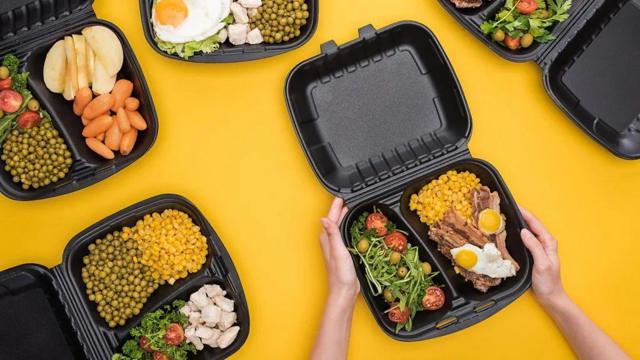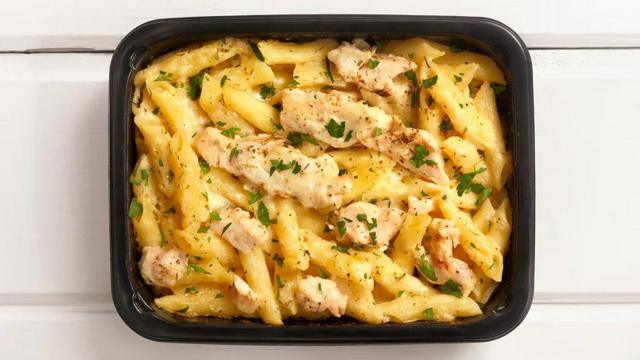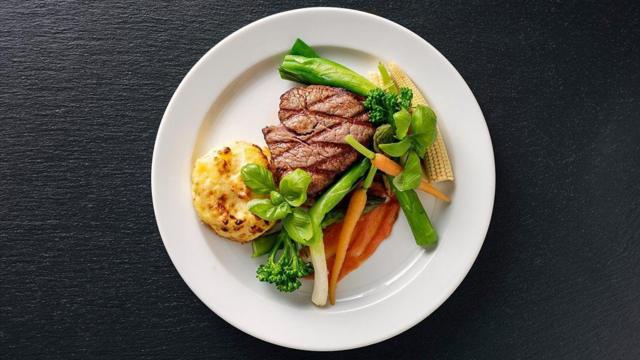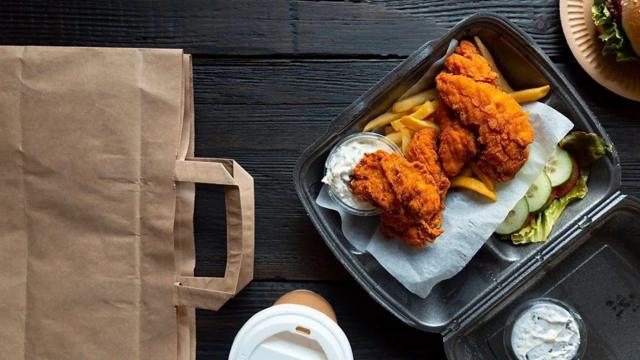There is nothing dangerous about microwave radiation. But does this apply to plastic packages in which food is heated? Here's what the latest research says.
For decades, the microwave oven has been and remains the workhorse of our kitchens. However, this item of household use has given rise to so many discussions and opposing opinions.
The microwave was called a real savior for those who could not and would not cook, while some chefs claimed that this invention was killing the art of cooking.
But there is another eternal question, and it is not about the subtleties of culinary art: when is cooking in the microwave harmful to health?
According to the World Health Organization, microwave radiation poses no risk when used correctly. But there are other concerns, including whether cooking food in the microwave causes nutrient loss and whether heating food in plastic containers can cause hormonal disruption.
Lost nutrients?
Some studies show that vegetables lose some of their nutritional value in the microwave.
For example, up to 97% of flavonoids – phytochemicals with antimicrobial and antioxidant properties – can disappear from broccoli. This is a third more than after cooking.
However, one 2019 study indicated that previous experiments with broccoli were carried out at different temperatures, different cooking times and did not take into account whether the product was in water.
It turned out that with short cooking (when these vegetables were left in the microwave for one minute), the nutrients did not disappear. Steaming or microwaving can even increase the amount of flavonoids.
"Under the cooking conditions used in this study, microwaving proved to be a better way to preserve flavonoids than steaming," the scientists wrote.
At the same time, they found that if you cook broccoli in the microwave with too much water (about the same amount we use when cooking in a pot), the amount of flavonoids decreases.
A conventional oven can become a competitor of the microwave oven, experts say.
A 2020 study compared the nutritional value of microwaved frozen meals to the same meals cooked in a conventional oven. The researchers found that the only difference between the two was that the microwaved dish retained slightly more vitamin C. But the scientists did not explain why.

PHOTO BY GETTY IMAGES image captionSome foods, such as green peas, lose nutrients when steamed or microwaved, but others, such as beans, do not
There is no single explanation for how microwaving increases flavonoid levels, says Xiang Li Wu of the USDA's Beltsville Research Center.
Perhaps they are simply easier to detect and isolate after microwaving, and there is no increase in quantity here.
There is also no clear answer to the question of whether vegetables retain more nutrients after microwaving than after other cooking methods, according to Xiang Li Wu.
"While the microwave is generally the best tool for cooking, the optimal cooking time will vary for different vegetables," he explains.
So even if the microwave is the best tool, it is not for all plant-based food.
In another study, scientists compared the content of phenols (compounds that act as antioxidants and have many health benefits) in different vegetables after cooking, steaming, and microwave cooking.
Microwaving and steaming reduced the phenolic content of pumpkins, peas, and leeks, but not spinach, peppers, broccoli, or green beans. The researchers also tested antioxidant activity.
It turned out that the best indicators were not boiled vegetables, but processed in a microwave oven.
A recent study from 2023 also showed good results for microwaves. Scientists compared the effect of cooking, steaming and microwaving different vegetables and concluded that microwave processing is the most effective for preserving substances.
Overheated plastic?
We often microwave food in a plastic container or package. In this regard, scientists warn about the risk of inhaling phthalates (esters of phthalic acid, which, in particular, are used during the production of plastic dishes and packaging - Ed .).
During high-temperature processing, these toxic additives can break down and enter the food.
"Some types of plastic are not suitable for use in microwave ovens because they are made of polymers that melt when heated, and when the temperature exceeds 100 degrees Celsius, they can end up in food," says Jumin Tan, a professor of food engineering at Washington State University. .

PHOTO BY GETTY IMAGES Photo caption When food is heated in plastic containers, toxic phthalates can break down and enter the food
In a 2011 study, scientists bought more than 400 plastic food containers and found that most of them released chemicals that disrupt the functioning of hormones in the human body.
Phthalates are the most common additives that make plastic more flexible. They are often found in food containers, plastic packaging and water bottles. As it turned out, phthalates disrupt the work of hormones and our metabolic system.
In children, phthalates can increase blood pressure and insulin resistance, which increases the risk of metabolic diseases - for example, diabetes and hypertension. Infertility, asthma and attention deficit disorder have also been linked to phthalate exposure.
Phthalates are also potential thyroid hormone disruptors, says NYU School of Medicine professor Leonardo Trasande. These hormones, among other things, are crucial for the development of the baby's brain during pregnancy.
BPA is also a common component of plastic products, and studies indicate that it can disrupt human hormones. A 2020 study shows that bisphenol A, which can enter the body with food, is capable of disrupting the behavior of cells and blocking the action of natural hormones by binding to their receptors inside cells. According to researchers, it can lead to cancer, hormone disruption, fertility problems, and affect our immune system.
But there are few such studies compared to those studying the effects of phthalates.
Phthalates are everywhere, from toys to body lotions, and it's still not entirely clear how much harm they cause. But most experts agree that heating food in a plastic container containing phthalates can increase their impact on the human body.

PHOTO BY GETTY IMAGES Photo caption Phthalates, as scientists have found, disrupt the work of hormones and our metabolic system
"Heating in a microwave activates pollutants," says Professor Rolf Halden, director of the Biodesign Center at Arizona State University. "This process is used in laboratories to isolate contaminants from samples before starting chemical analysis."
At the same time, as Trasande notes, the level of potential risk does not necessarily depend on how often a person reheats food in a plastic container. The relationship here is non-linear.
“From numerous studies, we now know that low levels of exposure may be the most dangerous. And there is no level that can be called safe," he says.
It is important to remember that when the plastic container is heated, the danger comes from those surfaces that do not come into contact with the food. For example, moisture can condense on the lid, which contains harmful substances, which then fall into the food in the form of droplets," Halden emphasizes.

PHOTO CREDIT: GETTY IMAGES image captionTo minimize the risk when heating food in the microwave oven, use ceramic dishes instead of plastic containers
The most reliable way to minimize risks is not to use plastic containers, but, for example, ceramic dishes. If using plastic, avoid a situation where the container is deformed, as old and damaged containers are more likely to release chemicals.
You should also check the labeling on the container itself: those with the number 3 and the letters “V” or “PVC” contain phthalates.
Temperature risks?
But even if you do away with plastic utensils, other potential health hazards remain: for example, uneven heating of food and the high temperatures used in microwave ovens.
Try to use the microwave not for cooking (because food can be heated unevenly in it - and, accordingly, some parts of the food will be less ready), but for reheating already cooked food.
"Depending on the size of the portion, some parts of the dish may heat up more than others," says Francisco Diez-Gonzalez, a professor at the University of Georgia (USA). – In the cross-section of the product, the temperature of its different layers may differ. It is difficult to achieve absolutely uniform heating, especially when it comes to a dish made from raw products."
However, it is important to note that warming up also carries risks. Food must be heated until it reaches a temperature of 82 degrees Celsius - then all harmful bacteria die.
But every time the food cools, these bacteria are formed especially actively, and it will be more difficult to get rid of them the next time it is reheated. Therefore, it is not worth reheating food more than once.

PHOTO BY GETTY IMAGES Photo caption Microwave ovens are better for heating than cooking. But some products should not be reheated more than once - especially rice
High temperatures in the microwave can also pose some risk. However, the problem is not the temperature itself. Some studies have shown that there is a risk associated with cooking starchy foods, particularly cereals and root vegetables.
When Betty Schwartz, a professor at the Hebrew University of Jerusalem, saw her students microwave potatoes while wearing their uniforms during their lunch break, she noticed the small crystals that had formed in the potatoes.
After examining them, she discovered that these crystals contained a lot of acrylamide, a chemical used in the production of polymers that is considered toxic. In this case, acrylamide became a byproduct of cooking potatoes.
Schwartz asked students to boil potatoes and found that no acrylamide was formed after cooking. She came to the conclusion that the reason for this is the high temperature of the microwave oven.
This is a concern because animal studies have shown that acrylamide acts as a carcinogen by interfering with the DNA of cells. There is still little evidence that it works in the same way in humans.
There are some studies that show that cooking food in the microwave contributes more to the formation of acrylamide than other methods.
However, the researchers also found that brief exposure to microwaves — such as blanching or defrosting — at low power can limit acrylamide formation during further cooking.
"At 100 ºС, enough energy is released to change the bonds between molecules and create a molecule that can react with DNA, generating mutations," says Schwartz. "When there are many mutations, oncology can occur."
Animal studies have shown this to be the case with acrylamides.
One way around this is to soak the potatoes in water before putting them in the microwave.
Dangerous radiation?
As for microwave radiation, it is absolutely harmless. These devices operate on low-frequency electromagnetic radiation similar to that used in light bulbs and radios.
Food placed in a microwave oven absorbs these microwaves, which causes the water molecules in the food to vibrate, creating friction and thereby heating it.
Humans are also able to absorb electromagnetic waves. But microwave ovens produce relatively low-frequency waves that do not go beyond the device.
Even if they did come out, these waves are safe, says Professor Tan. (But of course, high temperatures in the microwave are not safe at all, so you should never try to put a living thing in there!)
"We are exposed to waves, such as in a microwave oven, every day. People even exchange such radiation among themselves, says Jumin Tan. "If you're eating grain products grown in the sun, you don't have to worry about microwaved food."
Unlike X-rays, microwaves do not use ionizing radiation, which means they do not have enough energy to separate electrons from atoms.

PHOTO CREDIT: GETTY IMAGES Image caption Microwaves do not use ionizing radiation, so there is nothing dangerous about using them to heat food
"To damage DNA, you need to break chemical bonds. This is the main way in which radiation kills: cells begin to mutate, and oncology develops," explains Timothy Jorgensen, associate professor of radiation medicine at the Georgetown University Medical Center (USA).
According to him, all worries about microwave radiation were removed in the first years after the invention of the microwave oven.
In particular, scientists from the military research center under the US Department of Defense have conducted many studies on the safety of microwaves. And this largely dispelled fears.
The microwave has long been recognized as a safe kitchen appliance, but modern research shows that it comes with caveats. There are points that should be noted.
And experts in particular continue to be concerned about how the plastic packaging we use when putting food in the microwave oven can affect our hormones – and as a result, our health in general.

